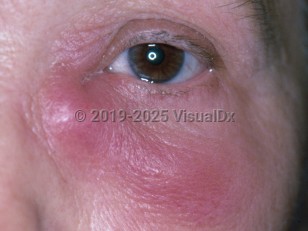Dacryocystitis - External and Internal Eye
See also in: Cellulitis DDxAlerts and Notices
Important News & Links
Synopsis

Dacryocystitis refers to inflammation of the lacrimal sac, usually related to obstruction of the nasolacrimal duct. It may be acute or chronic. The most common cause of dacryocystitis is lacrimal duct stenosis or blockage with stagnation of lacrimal excretions and resultant infection. The most commonly identified bacterial isolates are species of staphylococci and streptococci, but gram-negative organisms, such as Haemophilus and Pseudomonas, and anaerobes may also cause the condition.
Acute dacryocystitis usually presents with the sudden onset of pain, swelling, and erythema at the medial canthal region. Chronic dacryocystitis most commonly manifests as the insidious onset of epiphora (excessive tearing). In the vast majority of cases, the site of obstruction is nasal rather than ocular (nasal tumors or foreign bodies, congenital malformations, inflamed nasal mucosa, post-traumatic anatomic abnormalities, etc). Other conditions and treatments that may predispose to lacrimal outflow obstruction include chemotherapy, radiation, lymphoma, granulomatosis with polyangiitis, sarcoidosis, and cicatricial pemphigoid.
Acute dacryocystitis may lead to formation of a lacrimal sac abscess (which can rupture and drain through the skin), conjunctivitis, preseptal cellulitis, and even spread of the infection to the orbit with subsequent orbital cellulitis. Treatment is with topical and systemic antibiotics acutely; chronic disease often requires surgery. In adults, dacryocystitis is more common in middle-aged to older women, as the occurrence is more prevalent with increasing age. It may occur less frequently in individuals of African descent due to slight anatomical differences.
Codes
H04.309 – Unspecified dacryocystitis of unspecified lacrimal passage
SNOMEDCT:
85777005 – Dacryocystitis
Look For
Subscription Required
Diagnostic Pearls
Subscription Required
Differential Diagnosis & Pitfalls

Subscription Required
Best Tests
Subscription Required
Management Pearls
Subscription Required
Therapy
Subscription Required
Drug Reaction Data
Subscription Required
References
Subscription Required
Last Updated:08/25/2019

